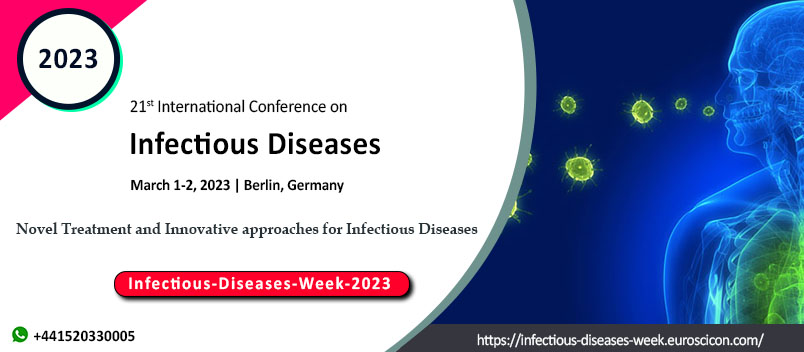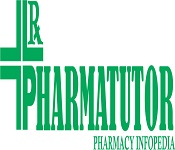Infectious Diseases Week 2023
About Conference
The 21st International Conference on Infectious Diseases, which will take place March 01–02, 2023, in Berlin, Germany, will organize physical sessions by providing a physical platform to all academicians, researchers, industry professionals, scholars, and physicians. Conferences will be scheduled on a variety of topics, and it will be beneficial for the scientific fraternity to stay connected while remaining at their preferred location. The Infection Diseases Conference hosts presentations from editors of eminent refereed journals, renowned and active investigators, and decision makers in the fields of infectious diseases, microbiology, immunology, infection control, and prevention. The Infection Control 2023 Organizing Committee also invites young investigators at each and every career stage to submit abstracts reporting their latest scientific research in oral and poster sessions.
What’s new?
The infectious Diseases research has moreover set itself the undertaking of working on numerous levels to set up activities gone for improving collaborations between researchers in fundamental and clinical research and to encourage interdisciplinary research exercises. On an instructive level, the exploration bunch goes for supporting the training and direction of youthful researchers by giving amazing preparing chances to PhD understudies and postdoctoral colleagues. It additionally gives a chief interdisciplinary stage to specialists, professionals and teachers to display and talk about the latest developments, patterns, and worries and in addition useful difficulties experienced and arrangements embraced in the fields of Current Trends in Infectious Diseases
Target Audience
- Infectious Diseases Students
- Infectious Diseases Scientists
- Infectious Diseases Researchers
- Infectious Diseases Faculty
- Medical Colleges
- Infectious Diseases Associations and Societies
- Business Entrepreneurs
- Training Institutes
- Manufacturing Medical Devices Companies
- Young Research people
- Business Entrepreneurs
- microbiologists
- Healthcare Industries
- Pharmaceutical Industries
Infectious Diseases meetings gives a worldwide stage to worldwide systems administration and trading most recent advancements in microbiological techniques and immunotherapy, offering chance to go to the introductions conveyed by eminent specialists from everywhere throughout the world. With individuals from around the globe concentrated on finding out about immunology and its advances this is your best chance to achieve the biggest collection of members from the Infectious Diseases group. Direct introductions, disseminate data, meet with present and potential researchers, make a sprinkle with new medication improvements, and get
Session and Tracks
Track-1 Transmission and Prevention
Transmission is the process of passing a disease or a disease causing pathogen from an infected host individual or a group of infected people to a particular individual or a group of persons regardless whether they are previously infected or not. Prevention is the application of scientific methodologies in order to prevent or moderate major human dysfunctions before they occur. The Centers for Disease Control and Prevention has introduced different strategies for reducing the STD risk which include: vaccination, mutual monogamy, reducing the number of sexual partners and abstinence. The most effective way to prevent sexual transmission of STIs, HIV / AIDS is to avoid the contact of body parts or fluids which can lead to transfer with an infected partner.
Track-2: Paediatric HIV
Human immunodeficiency virus (HIV) infection were identified, the number of children infected with HIV has risen dramatically in developing countries, the result of an increased number of HIV-infected women of childbearing age in these areas. HIV is a retrovirus and can be transmitted vertically, sexually, or via contaminated blood products or IV drug abuse. Vertical HIV infection occurs before birth, during delivery, or after birth.
Track 3: Antigen-antibody reactions
Antigen-antibody interaction, or antigen-antibody reaction, is a specific chemical interaction between antibodies produced by B cells of the white blood cells and antigens during immune reaction. The antigens and antibodies combine by a process called agglutination. It is the fundamental reaction in the body by which the body is protected from complex foreign molecules, such as pathogens and their chemical toxins. In the blood, the antigens are specifically and with high affinity bound by antibodies to form an antigen-antibody complex. The immune complex is then transported to cellular systems where it can be destroyed or deactivated.
Track 4: Reproductive infectious diseases
Reproductive tract infection (RTI) are infections that affect the reproductive tract, which is part of the Reproductive System. For females, reproductive tract infections can affect the upper reproductive tract (fallopian tubes, ovary and uterus) and the lower reproductive tract (vagina, cervix and vulva); for males these infections affect the penis, testicles, urethra or the vas deferens. The three types of reproductive tract infections are endogenous infections, iatrogenic infections and the more commonly known sexually transmitted infections. Each has its own specific causes and symptoms, caused by a bacterium, virus, fungus or other organism. Some infections are easily treatable and can be cured, some are more difficult, and some are non curable such as AIDS and herpes
Track 5: Mycobacterial infections
Mycobacterium is a genus of Actinobacteria, given its own family, the Mycobactericidal. Over 190 species are recognized in this genus. This genus includes pathogens known to cause serious diseases in mammals, including tuberculosis (Mycobacterium tuberculosis) and leprosy (Mycobacterium leprae) in humans. The Greek prefix myco- means "fungus," alluding to the way mycobacteria have been observed to grow in a mold-like fashion on the surface of cultures. It is acid fast and cannot be stained by the Gram stain procedure.
Track-6: Social and Legal Issues
The social issues associated with HIV and sexually transmitted diseases can be understood in two ways. Firstly, they social impact might refer to the social determinants of the pandemic and secondly, they relate to the social impact of the pandemic. Ethical questions present some of the most vexing problems associated with HIV infection and sexually transmitted diseases. Ethics cannot be considered in a vacuum. The social context dictates how the principles of ethics are applied and interpreted.
Track-7: Clinical Research and Case Reports
STD’s clinical research help scientists find improved ways to prevent, detect, or treat HIV/AIDS and other sexually transmitted diseases. All the medications used to treat HIV/AIDS in the United States were first studied in clinical trials. HIV/AIDS clinical studies under way include studies of new medicines to inhibit or treat HIV, studies of vaccines to prevent or treat HIV, studies of medicines to treat infections correlated to HIV. Case report is the detailed information of the individual patient containing the symptoms, signs, diagnosis, and treatment and follows up of the patient. It is a demographic profile that usually describes an unusual or novel occurrence.
Track-8: Co-infections Associated with STD
Co-infections are the simultaneous infections of a host by multiple pathogen species. There are different co-infections that are associated with STD especially with HIV which leads to lethal condition and worsens the condition of the individual. Co-infection is of particular human health importance because these pathogen species can interact within the host. The net effect of the co-infection on human health is thought to be negative but these Interactions can have either positive or negative effects on other parasites. Under positive parasite interactions, disease transmission and progression are enhanced which is also known as synergism and in negative parasite interactions include microbial interference when one bacterial species suppresses the virulence or colonisation of other bacteria.
Track-9: Health Services and Systems
Health system or health care systems is the organization of people, institutions, and resources that deliver health care services to meet the health needs of target populations. There are a lot of health care systems with many histories and organizational structures of the nations which are designed based on their needs and resources constrained to that nation. Besides there is a concerted effort among governments, trade unions, charities, religious organizations, or other coordinated bodies to deliver planned health care services targeted to the populations they serve. Health services is a multidisciplinary scientific field that examines the how people get access to the health care practitioners, health care services, costs, and what happens to the patients as a result of this care.
Track 10: Antimicrobial Drug Resistance (AMR)
AMR is said to be the ability of a microbe to withstand the effects of medication that once might successfully treat the microbe. The word antibiotic resistance (AR or ABR) is a detachment of AMR, as it relates only to the bacteria becoming resistant to antibiotics. Resistant microbes are more problematic to treat, requiring alternative medications or higher doses of antimicrobials. These methodologies may be more expensive, higher toxicity risk or both. Microbes resistant to numerous antimicrobials are called multidrug resistant (MDR). The classes of drug resistance are extensively drug- resistant (XDR) and totally drug- resistant (TDR).
Track 11: Pathogenic Infections
One of the commonly seen bacterial infections is tuberculosis with the utmost risk factor, affected by Mycobacterium tuberculosis bacteria, which kills about 1.5 to2 million people a year, frequently in sub-Saharan Africa. Pathogenic bacteria subsidize to other globally important diseases, which include pneumonia and foodborne illnesses. Pathogenic bacteria can also be the reason for the infections like tetanus, typhoid fever, diphtheria, syphilis, and leprosy. Pathogenic bacteria are also the reason of high infant mortality rates in developing countries.
Track 12: Infections During Diabetes
In commonly spreading infectious diseases are more frequent and serious in patients with diabetes mellitus, which naturally increases their morbimortality. The superior incidence of infections in diabetic patients is caused by the hyperglycaemic environment that favour’s immune dysfunction, micro- and macro-angiopathies, neuropathy negotiate the antibacterial activity of urine, gastrointestinal and urinary dysmotility, and increase the chances of medical complications in these patients.
Track 13: Imaging of Infections with Next Generation Microscopy
By the development of metabolic and infection imaging it has been routine process, as it shows the accurate and most valuable information of the infection site, type and resistance, which interne helps in treating efficiently, with the known cause and specificity. But in direct identification of infection in the body without any externally observed abnormality. But by using the cross sectional imaging technique and imaging the sedimentation of radioisotopes that have been settled into white blood cells or glucose. Biologic imaging is useful in discovering the anatomic sites where there is inflammation or high metabolic demand. However, a drawback of biologic imaging is that it is not specific for infection.
Track 14: Testing and Health Monitoring
Health monitoring is the way of checking if the health of the particular individual is being harmed from exposure to various disease causing micro-organisms which aims to detect early signs of ill health or disease. The health monitoring includes numerous tests for determining the health of an individual. You can use the health monitor to create a collection of tests, referred to as a health policy, and apply the health policy to one or more appliances. HIV testing refers to shows whether a person has HIV or not. The Centers for Disease Control and Prevention (CDC) recommends that everyone between the 13 to 64 years old get tested for HIV at least once and that people at high risk of infection get tested more often.
Track 15: Public Health
Public health is the science of defensive and educating the health of people and their communities. This work is attained by promoting healthy lifestyles, researching disease and injury prevention, and detecting, preventing and responding to infectious diseases. Public health professionals try to avoid problems from happening or recurring through executing educational programs, recommending policies, managing services and conducting research—in contrast to medical professionals like doctors and nurses, who focus mainly on treating individuals after they become sick or injured. Public health also works to limit health differences.
Track 16: Recent emerging infectious diseases
An emerging infectious disease (EID) is a contagious disease whose occurrence has boosted in the last 50 years and chances are there that it could increase in the coming future. Emerging infections account for at least 15% of all human pathogens. EIDs are caused by freshly identified strains that may have emerged from a known infection or transferred to a new community or to a field undergoing conserves metamorphosis, or remerging infections. Of thriving concern are adverse synergistic communication between emerging diseases and other infectious and non-infectious conditions ruling to the evolution of unusual syndetic.
. Track 17: Patient organizations and their role in drug development or clinical research
Rare disease drug development could benefit substantially from increased patient engagement and input to enhance understanding of the key aspects of disease impact, ways to measure these impacts and patients' perspectives on the benefit-risk profile of potential therapies
Track 18: Preventing Mother-to-Child Transmission of HIV
Mother-to-child transmission of HIV is the spread of HIV from an HIV-infected woman to her child during pregnancy, childbirth (also called labor and delivery), or breastfeeding. Mother-to-child transmission of HIV is also called perinatal transmission of HIV. Mother-to-child transmission is the most common way that children become infected with HIV. The HIV medicine reduces the risk of infection from any HIV that may have entered a baby’s body during childbirth.
Track 19: Blood stream infections or blood poisoning
Blood stream infections/ blood poisoning occurs when a bacterial infection elsewhere in the body such as in the lungs or skin which enters the blood stream. This is dangerous because the bacteria and their toxins can be carried through the blood stream to the entire body. It is a very serious condition that can lead to organ failure and even death. Blood poisoning requires immediate treatment. Unless it is treated quickly, the bacteria in the blood can cause sepsis. The symptoms of blood poisoning are similar to that of cold or of the flu.
Track 20: Covid-19
Coronavirus disease (COVID-19) is a virus-borne infection caused by the SARS-CoV-2 virus.
Most patients infected with the virus will have mild to severe respiratory sickness and will recover without needing any specific therapy. Some, though, will get very ill and require medical treatment. People over the age of 65, as well as those with underlying medical disorders such as cardiovascular disease, diabetes, chronic respiratory disease, or cancer, are at a higher risk of developing serious illnesses. Anyone of any age can become very ill or die as a result of COVID-19.
Market Analysis
The Worldwide Infectious Disease diagnostic market was esteemed at $23,321.99 million in 2020, and is appraised to reach $39,941.37 million by 2030, budding at a CAGR of 6.8% from 2021 to 2030. Infectious disease analysis is distinct as a laboratory test, which is implemented with the help of capable technicians and physicians to analyze Infectious Diseases 2023. It is a diagnostic method in which the causative creature of an infectious disease is categorized and identified. The sample of urine, blood, mucus, or other body fluids are evaluated to provide information about the causative organism by the use of various diagnosis procedure and instruments.
Evolution of the inclusive infectious disease analytic market is majorly determined by escalation in occurrence of infectious disease such as hepatitis, influenza, COVID-19, & Human Immuno Deficiency Virus (HIV); upswing in petition for point-of-care analytical test; rise in funding from private & government administrations for analytical service centers; and expansions in technologies in the field of infectious disease diagnostics. According to the Interiors for Disease Control and Prevention (CDC), in 2018, it was described that roughly 1.7 million infections and 99,000 related deaths arise every year in American hospitals. Furthermore, surge in call for point-of-care testing is estimated to fuel the progress of the infection disease diagnostic market. For example, in March 2020, Abbott, a global healthcare company, stated the launch of Abbott ID NOW COVID-19 test, which is a molecular point-of-care test used to identify COVID-19 in as slight as 5 minutes. In addition, increase in geriatric population fuels the market growth, due to the fact that aged persons are more at risk to infectious diseases 2023. According to the U.S. Food and Drug Administration (FDA), in 2020, it was described that from place to place 300,000 those aged 50 and above are analyzed with pneumococcal pneumonia, every year. In May 2021, Neuberg Diagnostic, a most important company that bids best-in-class laboratories, propelled the clinical laboratory's operation in the U.S. to deal genomic and molecular challenging on new generation sequencing technology.
Due to factors such as an increase in the prevalence of infectious diseases, the presence of active participants, the upgrading of medical facilities, the availability of open clinical research services, and the development of indicative instruments in the region, North America accounted for a significant portion of the global market for infectious disease diagnostics in 2021 and is likely to continue to dominate throughout the estimate period. However, due to the spread of infectious diseases, the rise in demand for early treatment, the strengthening of the medical care system, and novel developments in demonstrative testing, Asia-Pacific is probable to rise rapidly in the next years.
Developments recently:
The Cobas 5800 System, equipment for sub-atomic research facilities, had its first irresistible infection tests in December 2021 in countries that accept the CE certification.
The market study on infectious disease diagnostics focuses on:
Evaluation of the market
Competitive Environment for COVID in Premium Insights
Historical Information, Forecasts, and Company Profiles
Learn More
Top most Infectious Diseases Universities in World
Infectious Diseases Universities in Europe
University of Cambridge | University of Oxford | University of Copenhagen | University College London | Swiss Federal Institute of Technology Zurich | Imperial College London | University of Zurich | Karolinska Institute | University of Manchester | University of Munich | University of Edinburgh | Pierre and Marie Curie University | Catholic University of Leuven | Heidelberg University | University of Helsinki | Freie Universität Berlin | Utrecht University | Uppsala University | Wageningen University and Research Center | University of Barcelona | Humboldt-Universität zu Berlin | University of Basel | Technical Leiden University | University of Groningen | University of Strasbourg | University of Munich | Ghent University | King's College London | University of Geneva | University of Dundee | Lund University | University of Gothenburg | University of Göttingen | University of Freiburg | Stockholm University | University of Sheffield | Eberhard Karls University, Tübingen | University of Amsterdam | University of Padua | University of Würzburg | Université Paris-Sud | University of Vienna | University of Bristol | University of Milan | University of Nottingham | University of Hamburg | University of Lisbon | Free University of Brussels | University of Oslo | University of Southampton | University of Leeds | University of Birmingham | University of Bern | University of Cologne | University of Münster | Medical University of Vienna | University College Dublin | University of Aberdeen | University of Liverpool | Trinity College Dublin | Delft University of Technology | Bielefeld University | University of Warsaw University of Leipzig | University of York | Cardiff University | University of Regensburg
Infectious Diseases Universities in USA
Augusta University | Wayne State University | Penn University | University of Maryland | Drexel University | University Of Miami | University of Georgia | Harvard University | Washington University | University of Illinois | University of Minnesota | University of Charleston | West Virginia University | University of Wisconsin | University of Wisconsin | University of Washington | University of Appalachia | Duke University | University of California | University of Melbourne | University of Toronto | University of Pennsylvania | Cornell University | Yale University | University of Michiga | Washington University in St Louis | McGill University | University of North Carolina at Chapel Hill | Boston University | McMaster University | University of California | Northwestern University | University of British Columbia | University of Pittsburgh | New York University | Emory University | Vanderbilt University | Case Western Reserve University | University of Southern California | Tufts University | Dartmouth College | University of California, Davis | University of Wisconsin-Madison | Ohio State University | University of Virginia | University of Florida
Infectious Diseases Universities in ASIA
Osaka University | University of Tokyo | National University of Singapore | Kyoto University | Mahidol University | Tel Aviv University | University of Hong Kong | Keio University | Hebrew University of Jerusalem | Seoul National University | National Taiwan University | Sun Yat-sen University | Fudan University | Zhejiang University | Peking University | Hokkaido University | Tehran University of Medical Sciences | Tohoku University | Shanghai Jiao Tong University | Yonsei University | Korea University | Shandong University | Sungkyunkwan University | University of Ulsan | Chang Gung University | Capital Medical University | National Yang-Ming University
Infectious Diseases Associations and Societies
Europe Region
Aids Hilfe Wien Austria | European Centre for Disease Prevention and Control| Belgium | EATG(European AIDS Treatment Group) Belgium | ILGA Europe (The European Region of the International Lesbian, Gay,| Bisexual, Trans and Intersex Association ) Belgium | Stop AIDS alliance Belgium | Czech AIDS Help Society Czech Republic | AIDS Fondnet Denmark | Deutche AIDS-Hilfe / AIDS Action Europe Germany | Positive Voice Greece | European Society for Paediatric Infectious Diseases | HIV Ireland(Dublin AIDS Alliance CLG) Ireland| Lila (Lega Italiana per la Lotta contro l’AIDS) Italy | Global Network of People Living with HIV Netherlands | ICRSE(International Committee on the Rights of Sex Workers in Europe) Netherlands/UK | Social AIDS Committee Poland | ARAS- Romanian Association against AIDS Romania | Alliance Global Ukraine | EATAN(European African Treatment Advocates Network) United Kingdom| Terrence Higgins Trust United Kingdom | British HIV Association | European Society for Pediatric Infectious Disease(ESPID) | European Centre for Disease Prevention and Control(ECDC) | European Society for Infectious Diseases in Obstetrics and Gynecology (ESIDOG) | European Society of Clinical Microbiology and Infectious Diseases(ESCMID)| Italian Society of Infectious and Tropical Diseases(SIMIT)
Asia Region
International AIDS Society- Asia | AIDS Society of Asia and the Pacific | Australasian Society for HIV Medicine| APCASO, Thailand | Malaysian AIDS Council | Kenya's National AIDS Control Council | Japanese Association for Infectious Diseases | Asian-Pacific Research Foundation for Infectious Diseases (ARFID)| Australasian Society for Breast Disease (ASBD) | Infectious Diseases Society of Taiwan | HIV Medicine Association (HIVMA)
USA Region
American Academy of HIV Medicine | American Medical Association | Association of Nurses in AIDS Care | HIV Medicine Association | International AIDS Society – USA | International Association of Physicians in AIDS Care | National Alliance of State and Territorial AIDS Directors| National Medical Association | Physicians' Research Network | American Academy of HIV Medicine | Gay and Lesbian Medical Association | AIDS Services Directory | Infectious Diseases Society of America | Brazilian Society of Infectious Diseases | American Society of Breast Disease (ASBD) | American Association for the Study of Liver Diseases (AASLD) | Association of Medical Microbiology and Infection Disease Canada(AMMI Canada) | American Society for Gastrointestinal Endoscopy | International Society for Infectious Diseases | Association of Medical Microbiology and Infectious Disease(AMMI) Canada
Infectious Diseases Journals
Europe Region
Transactions of the Royal Society of Tropical Medicine and Hygiene | Travel Medicine and Infectious Disease | Spatial and Spatio-temporal Epidemiology | Antimicrobial Resistance and Infection Control | New Microbes and New Infections | HIV Clinical Trials | Comparative Immunology, Microbiology and Infectious Diseases | Journal of Tropical Pediatrics | Infectious Diseases | Journal of Ophthalmic Inflammation and Infection | Journal of Infection and Chemotherapy | Transplant Infectious Disease Journal of Infection in Developing Countries | Journal of Infection and Public Health | Trials in Vaccinology | International Journal of STD and AIDS | Mediterranean Journal of Hematology and Infectious Diseases | British Journal of Biomedical Science | Journal of Chemotherapy | African Journal of AIDS Research | Iberoamericana de Micologia magazine | Journal of Water and Health | Jundishapur Journal of Microbiology | Infectious Disease Reports | The Lancet Infectious Diseases | FEMS Microbiology Reviews | The Lancet HIV | Journal of the International AIDS Society | Clinical Microbiology and Infection | Journal of Infection | Infectious Disease Clinics of North America | Frontiers in cellular and infection microbiology | Vaccine | International Journal for Parasitology | Infection Control and Hospital Epidemiology | International Journal for Parasitology: Drugs and Drug Resistance | Malaria Journal | Journal of Viral Hepatitis | International Journal of Medical Microbiology| Sexually Transmitted Infections | Journal of Clinical Virology | AIDS and Behavior | International Journal of Antimicrobial Agents | BMC Infectious Diseases | HIV Medicine | Tropical Medicine and International Health | Influenza and other Respiratory Viruses | International Journal of Tuberculosis and Lung Disease | International Journal for Parasitology: Parasites and Wildlife | AIDS Reviews | European Journal of Clinical Microbiology and Infectious Diseases | Ticks and Tick-borne Diseases | International Journal of Infectious Diseases | Journal of Hospital Infection | Diagnostic Microbiology and Infectious Disease | Pathogens and Disease
USA Region
Brazilian Journal of Infectious Diseases | Journal of the Brazilian Society of Tropical Medicine | Magazine of the Institute of Tropical Medicine of Sao Paulo | Journal of Venomous Animals and Toxins Including Tropical Diseases | Chilean Journal of Virology: official organ of the Chilean Society of Infectology | Malariology and Environmental Health Bulletin | Cuban Journal of Tropical Medicine | Infectious Diseases and Microbiology | Clinical Microbiology Reviews | Clinical Infectious Diseases | Journal of Infectious Diseases | Drug Resistance Updates | Emerging Infectious Diseases | AIDS | PLOS Neglected Tropical Diseases | Current Opinion in HIV and AIDS | Reviews in Medical Virology | Journal of Acquired Immune Deficiency Syndromes | Antimicrobial Agents and Chemotherapy | Current Opinion in Infectious Diseases | Advances in Virus Research | Infection and Immunity | Gut Microbes | AIDS Patient Care and STDs | Current HIV/AIDS Reports | Sexually Transmitted Diseases | Cellular and Molecular Immunology | American Journal of Tropical Medicine and Hygiene | Topics in antiviral medicine | Pediatric Infectious Disease Journal | Journal of the European Academy of Dermatology and Venereology | Microbiology spectrum





















